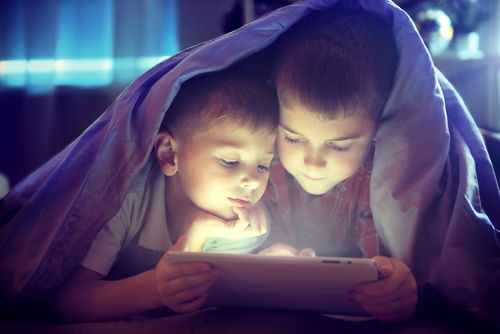The Dark Side of Wireless Technology

Wireless technology is modern magic. For the price of a device and a data plan, you are granted the power to communicate and connect to the World Wide Web through a pocket-sized screen. But some evidence suggests this magic has a dark side, and we may be paying more for it than we realize.
With an estimated 4.8 billion cellphone users worldwide, it’s hard to fathom that something so commonplace could pose health problems. Besides, since the 1990s, government and industry experts have maintained that cellphones are safe, and have pointed to studies that reveal no problems associated with wireless exposure.
Yet there is compelling evidence of harm. In 2015, an appeal letter to the United Nations signed by over 200 scientists from a group called International EMF Scientist wrote that the microwave radiation emitting from our phones and other wireless devices is “proven to be harmful to humans and the environment.” They pointed to effects such as cancer risk, a rise in harmful free radicals, genetic damage, structural and functional changes to the reproductive system, learning and memory deficits, neurological disorders, and a negative impact on our general well-being.
In 2016, the National Toxicology Program released a report from its 16-year, $25 million study examining the health impacts of wireless radiation. The study, which aimed to give the government a conclusive answer as to whether or not the radiation emitted from cell phones can cause harm, found that it can cause brain tumors, heart tumors and DNA damage.
This conclusion comes as no surprise in much of the developed world, where public health officials have taken evidence of harm seriously for years. In the United Kingdom, France, Belgium, Russia, and other nations, wireless users—especially children—are urged to minimize their exposure to microwave radiation.
But in the United States, public health officials have been hesitant to sound the alarm. In 2014, the Centers for Disease Control issued a public statement urging caution with cellphone use, but retracted the statement just a few weeks later.
Last month, the California Department of Public Health (CDPH) released consumer guidelines on how to lessen exposure to wireless radiation, particularly for children, citing a possible link to harmful health conditions like cancer and lower sperm count. But it almost didn’t happen. The CDPH made their recommendations several years ago, but refused to release them to the public until a lawsuit forced the agency to do so.
According to the San Francisco Chronicle, an attorney defending the CDPH’s decision to withhold the recommendations said the CDPH didn’t want to cause “unnecessary panic.”

‘Generation Zapped’
Filmmaker Sabine El Gemayel believes we deserve to have a better understanding of the health impact associated with wireless technology. That’s the mission of her new documentary, “Generation Zapped.”
“I made the movie because no one would believe me,” El Gemayel told The Epoch Times. “But that’s the power of media. When it’s well done, well documented, and doesn’t go into conspiracy theories or fake news, then people listen to the information and are willing to make lifestyle changes for the health of their family.”
But El Gemayel is having trouble getting her message to the public. Network representatives have expressed interest in distributing her film, but after consulting with their companies, the subject has often been deemed too damaging to their brand.
“Netflix, for instance, they do streaming, so they’re not going to show this film because of the nature of their business,” El Gemayel said.
“Generation Zapped” features scientists who discuss the dangers regarding wireless exposure, and individuals who claim to have gotten sick from it. The film also tells the story of a powerful wireless industry that has shaped policy for decades, ensuring that their devices and the field that powers them receive little oversight or scrutiny.
“It’s like the tobacco, chemical, or pharmaceutical industries. They tell us this stuff is safe, and then, decades later, you find out that they were hiding all this evidence that it was causing us harm,” said El Gemayel.
One of the experts featured in “Generation Zapped” is George Carlo, an industry scientist turned outspoken critic of wireless technology. In the 1990s, Carlo headed a $27 million research project funded by the cellphone industry to examine the health risks of these devices. The goal was to alleviate consumer fears that the technology might be harmful. But the story did not unfold as planned.
Carlo’s team found what has been echoed in many other studies: a correlation between cellphone emissions and DNA damage, as well as a slightly higher rate of brain tumors in cell users compared to non-users. But the industry dismissed Carlo’s findings and worked to discredit his reputation.
Through its lobbying power, the industry also managed to put the Federal Communications Commission—an agency with no previous experience in evaluating harm and health effects—in charge of cellphone safety.
“The system is broken with regard to protecting consumers from wireless signals,” Carlo said.
Microwave Sickness
Wireless technology communicates through a band of frequencies known as microwaves, named for their tiny wavelengths. All scientists agree that microwave exposure can damage our biology. The debate is about how much is necessary to cause illness.
The conventional notion regarding the safety of wireless rests on the assumption that only microwaves intense enough to cause a thermal reaction—like in a microwave oven—are considered harmful, says Carlo. Since wireless radiation falls below this thermal threshold, officials automatically consider these frequencies safe. As a result, cellphones were never subjected to premarket testing.
But many studies challenge this assumption. About 100 scientific reviews show that microwave exposure at nonthermal levels causes health effects.
“Studies around the world have clearly shown that it is the nonthermal, indirect effects that are of most concern today,” said Carlo.
When cellphones first emerged in the early 1980s, the pricey, brick-sized gadgets were restricted to a select few. Today, wireless is everywhere. Even if you are one of those few who doesn’t carry a cellphone, you’re still constantly exposed to microwave radiation emitting from Wi-Fi routers and cellphone towers, which saturate our environment in the name of good reception.
According to Olle Johansson, associate professor in neuroscience at the Karolinska Institute in Sweden, our bodies are subjected to one quintillion times (1,000,000,000,000,000,000) more electromagnetic radiation today compared to just a decade ago.
But if this ubiquitous technology is really so harmful, why don’t we see more problems related to it? According to Dafna Tachover, an attorney and founder of We are the Evidence—an advocacy group dedicated to protecting those who have been injured by wireless radiation—proof of health problems related to wireless is all around us. But the majority of doctors are blind to the signs.
Before Tachover studied law, she was a telecommunications officer, constantly on the computer. But soon after purchasing a new laptop in 2009, she fell ill with a variety of symptoms, such as a racing heart, sharp headaches, and an inability to concentrate. After six months, the symptoms became debilitating. Once she identified wireless as the problem, Tachover moved to the Catskill Mountains, where microwave radiation is minimal, and her symptoms disappeared.
Tachover has what is called electromagnetic hypersensitivity (EHS), a controversial condition usually characterized by a host of nonspecific physical and dermatological symptoms such as headaches, fatigue, skin rashes, or burning sensations.
The World Health Organization has recognized EHS since 2005, but note the difficulty in measuring how widespread it is. Some studies estimate up to 10 percent of the population suffers from EHS, and project this figure to grow. In 2015, a woman in France won a lawsuit for disability benefits related to her EHS, in what is one of the first cases of its kind to be recognized in court.
But Tachover rejects the EHS term. She prefers to use “microwave sickness,” a term used by the military 60 years ago when soldiers in both the United States and Russia developed neurological symptoms after prolonged exposure to radar.
“By calling it a sensitivity, you just describe the person that has it, rather than focusing on the environment that is making people sick,” Tachover said.
Symptoms of microwave sickness include headaches, heart palpitations, fatigue, nausea, dizziness, and more. But Tachover says that most people who experience signs of microwave sickness don’t think to associate it with wireless technology.
“I talked to a hotel manager recently who noted that every time he used his cellphone, his hands became paralyzed,” she said. “But he never thought he should stop using it. He was still waiting for the government to tell him that it’s harmful.”
Consumer Demand for Safer Tech
Although we lived comfortably without cellphones just a few decades ago, wireless has become a way of life. There are lots of frivolous applications, but many of our livelihoods now depend on cellphone access, and a wireless network has become an indispensable tool for countless industries.
But there’s no reason we need to be bathed in microwave radiation 24/7. One clear takeaway from “Generation Zapped” is that there are simple, painless habits we can adopt to substantially reduce our microwave exposure, such as turning your phone to airplane mode when not in use, or turning off your Wi-Fi router before bed.
Carlo believes there is a way that wireless technology and human biology can peacefully coexist, we just need the impetus to initiate it.
“The industry responds to what people want in their gadgets: more data, faster downloads, more pixels,” he said. “But there is not an incentive toward changing the signal forms, for example, so that these biological cascades are not triggered.”
El Gemayel believes her film can help foster the demand for safer technology, but only if people see it. With no distribution network, the film has only been shown in small community viewings.
But one recent screening could help significantly amplify the impact of her film. In December, “Generation Zapped” was featured at the Silicon Valley International Film Festival, a private festival for Google employees.
“It’s an accomplishment for me, because the movie is showing right where the technology is invented,” El Gemayel said. “These are the guys who can make the difference.”







Can you give me info on how safe or not the FitBit is? So many pros to using – but it is wireless…. ??